So… I have to add a supplement to my last trip blog. This was prompted because I received a text from a friend in regards to my fall 2012 Europe blog-
“Nine paragraphs on fashion, five on food, two on PERFUME and barely more than a paragraph on history?! You and I have different travel priorities, I think ”
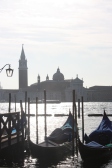
Venice
WELL…. I was TRYING to convey a broad, general feeling of Europe and how it appealed to the senses of smell, taste, and sight. I wanted people to feel that European je ne sais quoi- the romance of it all. I felt that romance in the delectable foods, the eye-pleasing fashion and landscapes, the delicious fragrances that I was constantly experiencing, and a more relaxed attitude of the people in Europe. But believe me, I think the historic education in Europe is probably one of the best parts! There’s just so much. But now that it’s been indirectly requested, I’ll try to summarize here.
Brief summary of the history from the tour, in order of the places that we visited:
– In London, I learned no history this trip. Last time I went, I visited the largest hindu temple in the world (outside of India) and we watched the changing of the guard at Buckingham Palace. We even caught a musical, Wicked. I’ve seen it twice and the London version was far superior. This trip, I arrived tired and jet-lagged a day later in London than I was supposed to. So we went for “afternoon tea” (scones, mini-desserts, exotic teas and fancy little sandwiches in an really modern hotel) and shopped Piccadilly Circus. The most notable thing about my London visit this time was the shopping at Boots drugstore. No history there. I mainly slept off my jet-lag and bought souvenirs.
–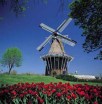 In Amsterdam, locals are proud of the fact that their city was actually originally under water and the resourceful Dutch (after starting to settle by the castle built on a dam by the Amstel River, hence “Amstel dam”) had to pump out the remaining water and make a town. They still keep the water out of North Holland with dykes and now the remaining canals have earned this city the nickname “Venice of the North“. Amsterdam was also the richest city in the world for a time during the 17th century and is still known for its diamond industry.
In Amsterdam, locals are proud of the fact that their city was actually originally under water and the resourceful Dutch (after starting to settle by the castle built on a dam by the Amstel River, hence “Amstel dam”) had to pump out the remaining water and make a town. They still keep the water out of North Holland with dykes and now the remaining canals have earned this city the nickname “Venice of the North“. Amsterdam was also the richest city in the world for a time during the 17th century and is still known for its diamond industry.
 – The popular “XXX” that has a very different meaning in many places today is actually derived from the 3 X’s of St. Andrew’s Crosses. They were used in the Amsterdam flag an are seen innocuously all over the city in completely non-taboo settings. Of course, they are still also used to mark risque places in Amsterdam as well.
– The popular “XXX” that has a very different meaning in many places today is actually derived from the 3 X’s of St. Andrew’s Crosses. They were used in the Amsterdam flag an are seen innocuously all over the city in completely non-taboo settings. Of course, they are still also used to mark risque places in Amsterdam as well.
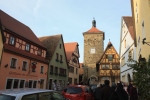
– The medieval German town of Rothenburg (Rothenburg ob der Tauber in Bavaria) was once called “the most German of German towns”. Unfortunately, many of the town dwellers at the time of WWII were Nazi supporters but this resulted in the preservation of the historic buildings during the war because the Nazis worked to protect their German treasure. It is now a popular destination for tourists and has been the setting inspiration Disney’s Pinocchio, some scenes in the Harry Potter movies, and many other stories and movies. It definitely feels very storybook German and is famous forSchneeballen (snowball cakes), Christmas shops, and cuckoo clocks. Visiting here is like taking a step back in time. I can imagine that it becomes even more magical when the occasional snowfall comes to town!
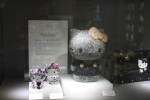 – Innsbruck in western Austria is a beautiful city located in a valley of the Alps. It has hosted several Winter Olympics. The crystal-cutting factory forSwarovski crystal products is nearby Innsbruck (in Wattens), established in 1895 so that company could take advantage of local Austrian hydroelectricity for the energy-intensive grinding processes that founder Daniel Swarovski patented.
– Innsbruck in western Austria is a beautiful city located in a valley of the Alps. It has hosted several Winter Olympics. The crystal-cutting factory forSwarovski crystal products is nearby Innsbruck (in Wattens), established in 1895 so that company could take advantage of local Austrian hydroelectricity for the energy-intensive grinding processes that founder Daniel Swarovski patented.
A little war history- Franz Ferdinand (Archduke Franz Ferdinand of Austria, not the band) was assassinated on June 28, 1914 in Serbia which was the main spark in a chain of events leading to WWI. After his assassination, Austria-Hungry declared war on Serbia and then the dominoes began to fall.
![]() – Italian, the latin-based language of love, is actually based on a version of the Tuscan dialect. When the regions that we now know as Italy (Sicily, Naples, Florence, Venice, etc) were uniting, they had to choose a common language. At the time, the dialects were different and it was difficult to choose one that most citizens would understand.
– Italian, the latin-based language of love, is actually based on a version of the Tuscan dialect. When the regions that we now know as Italy (Sicily, Naples, Florence, Venice, etc) were uniting, they had to choose a common language. At the time, the dialects were different and it was difficult to choose one that most citizens would understand.

A poet from the Tuscany region, Dante Alighieri, wrote his Florentian poetry in a italian dialect that educated citizens across Italy could understand. The version of italian that is used today was based on his writings. That explains why the language is so musical!
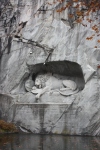
– Lake Lucerne has many popular tourist attractions including the Lion Monument, a statue dedicated to fallen soldiers, and the longest wooden covered bridge in Europe.
The Lion monument is set across from a small lake in a very quiet area. You walk through a small, peaceful park to get to it and the entire scene is just touching- the dying wounded lion looks so sad and you can imagine how significant the statue is to anyone who was close with someone that died at war.

The world’s oldest surviving truss bridge that was constructed in 1333 tells a story of the history of Lucerne. As you walk along the Chapel Bridge (or Kapellbrucke) that crosses the Reuss River, you watch the panels above you and the story unfolds through pictures that describe significant moments in their history. The pictures were partially lost in a fire in 1993 but there are still enough intact that you get a sense of the stories they are conveying.
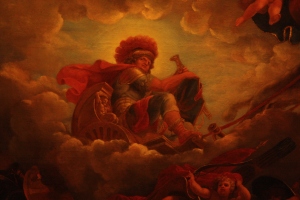
– In the Palace of Versailles, the ceilings of each room are painted with a mural centered around a Roman god to symbolize the room theme and what it was used for. Eg. Mars, god of war is on the ceiling of the room where war-related meetings were held (see picture above) vs. Diana, goddess of the hunt who is painted in the hunting room. Other rooms had Venus, Hercules, Apollo, and Mercury.
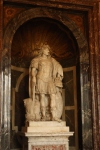
– King Louis XIV of France (the “Sun King“) built the Palace of Versailles so that the sun would rise to him (his bed is situated so that it faces directly east) and set directly behind him. Imagine the architectural work that went into making the Sun King realize his dream of having the sun appear to be at his command. After him, King Louis XV (the Sun King’s great grandson), took the throne and was affectionately known as the “Beloved King”. The king that many of us are familiar with was his grandson and successor, King Louis XVI. Louis XVI was married to Marie Antoinette and movies have been made about their time together during the harsh period when France was suffering. Their lives both ended during the French Revolution in a public beheading after they tried to secretly flee France to Marie Antoinette’s native Austria. The original punishment likely would’ve been less harsh if they hadn’t betrayed the country by attempting to leave. The French monarchy was abolished (for some time) after their reign ended.
– Or even how…. Well, there’s still too much to tell. That’s the beauty of Europe, it’s a constant discovery. I can’t wait to go back and see so many of the things that I missed- Tower of London (with more afternoon tea), Jack the Ripper tour of London, Anne Frank house and museum (“how COULD you miss it?” I know! It was too cold to wander around and try to find it), the Louvre in Paris, etc. Suggestions?
Ok, in point form, here’s some more of what we saw if you’re interested in looking these things up:
- The rock of Lorelei on the Rhine River that has inspired poetry
- Several of the castles built by “Mad King Ludwig” in Germany, including one that was built right on the Rhine River as a toll station with a water prison underneath
- The Piazza di San Marco in Venice with its famous buildings including the Clock Tower that also displays where the sun is currently positioned in the zodiac calendar
- The Uffizi Gallery in Florence that holds some spectacular art including one of my favorites, Primavera by Botticelli
- One of the longest tunnels in the world that we drove through (kind of had me feeling claustrophobic) while we were driving from Switzerland to France
- The gothic churches of France, including the details of Notre Dame (means “our lady”) in Paris that took approximately 200 years to complete
If I could somehow find a way to do my job AND travel the world, I promise I would dedicate more time to sharing the historic significance of all the places I visit 😉
Historically perspectived, Louis XIV’s successor was his great-grandson Louis XV ( it seems logical to see a XV between a XIV and a XVI, doesn’t it ?), and Louis XVI was Louis XV’s grandson . I hope your historical perspectives are clearer about the other countries you mention .
Notre-Dame means “Our Lady”, not our mother .
I appreciate the input. I changed Notre Dame to “our lady”, not “our mother”. You are correct on this… comment appreciated!
I think you re-iterated the exact same thing that I said about the King Louis’, however. It seems to me that we are already in agreement on this… am I wrong?
Yes, sorry . I re-read the paragraph and I must have have been in the twilight zone the first time . Don’t understand where my confusion came from . We fully agree on that point .
To apologize, i’ll add a note about LouisXVI and his “b…..” . Their betrayal was not only trying to escape . During the first 3 years of the revolution, when it was OK for the French to have a constitutional monarchy without absolutism as before, the king and the queen, but specially the queen, were continuously corresponding with other monarchs ( Austrian first) and exiled French nobles, encouraging them to invade France to get rid of the revolution . In 1792, when France was attacked by all the kingdoms of Europe, this mail exchange with the enemy was a case of high treason . When the queen was arrested, all the letters were found in her room . Those proofs were the main cause of the beheading . Marie-Antoinette never looked like the Hoolywood-bred US people think she was .
That is a detailed account! Your historical input is great, thanks! Hollywood definitely likes to glamorize things.
I read several detailed books about the 4 French revolutions, ( and the Russian one ), including things that are never taught in schools of course .
Did you know the origin of the red flag association with revolutions comes from the very day when Parisian people assaulted the Tuileries Palace, residence of the King since 1789, to put him in jail for the first time ? There’s a dark story behind that :
In 1791, a pacific unarmed crowd of poor Parisians gathered in the Champ-de-Mars ( the Eiffel Tower location) to submit a petition to the king . Then, the National guard, who belonged until this moment to the bourgeoisie, opened fire and killed hundreds of people . This was the infamous “massacre (slaughter) du Champ-de-Mars” . to do so, they showed the red flag, because the red flag on battlefields
until then meant “no mercy” . In memory of this atrocity, the Parisians who assaulted the King’s palace showed the red flag, using it for the first time and forever as a revolutionary emblem .
Before the slaughter, the revolution had been quite peaceful . One or two guys had been killed in the storming of the Bastille in 1789, but that was all . What I learned from my readings is that it was never the revolutionaries who started slaughtering, but always the reaction
. This is true for 1789 France and 1917 Russia, as well as many other places . So, the use of the red flag is a symbolic remembrance for those who know .
You know a lot about history, Phil… have you done a lot of traveling?
Yes I did . I’m interested by human greatness and dumbness . So I learn (real) history every time iIcan, and I did some travels to see the world from other point of views . When I do, I travel alone with a back bag and no plans, just the plane ticket and maps . My goal is always to be able to think and to feel like the locals . So little money and trying to learn the language to better meet people .
I lived adventures in the US, Canada, Brazil, Mexico, India, Haïti, Egypt, Morocco and around Europe . But Europe nowadays all looks the same, it seems every country is losing its particular soul . You really need to know the past and notice subtle things to enjoy it as it was the case yesteryears .